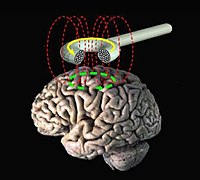
Photo from wikipedia
Transcranial magnetic stimulation (TMS) has the potential to treat a variety of psychiatric and neurological disorders. TMS has been used with success to treat major depressive disorder; however, researchers have… Click to show full abstract
Transcranial magnetic stimulation (TMS) has the potential to treat a variety of psychiatric and neurological disorders. TMS has been used with success to treat major depressive disorder; however, researchers have been exploring the TMS therapy for many other neurological disorders including schizophrenia. Unfortunately, because the disorder is not well understood and exhibits an extremely wide range of symptoms, a successful therapy has proven to be challenging. Although the symptoms are diverse, auditory hallucinations are one of the most common positive symptoms and show the most promise for treatment using TMS. The primary auditory cortex (PAC) is thought to be one region of the brain mediating such hallucinations. Furthermore, this region is relatively small, which makes it difficult to isolate from surrounding cortical regions. In order to attempt to stimulate this area alone without stimulating the surrounding areas, a coil that provides more focused stimulation is desirable. The commercial “figure-of-eight coil” (FOE) is very popular for TMS research; however, another coil, the quadruple butterfly coil (QBC), has proven to provide more focal stimulation than the FOE. To further investigate this, we have performed finite-element simulations with both the FOE and the novel QBC on heterogeneous head models derived from magnetic resonance images of both healthy and schizophrenic individuals. Our results show that when the QBC is above the PAC, it stimulates more targeted cortical matter than the FOE, while still retaining the depth necessary to stimulate the target volume sufficiently. Furthermore, this result remained consistent across the healthy and schizophrenic models. These results support the use of the QBC coil to provide focused stimulation beyond that provided by the FOE.
Journal Title: IEEE Transactions on Magnetics
Year Published: 2018
Link to full text (if available)
Share on Social Media: Sign Up to like & get
recommendations!